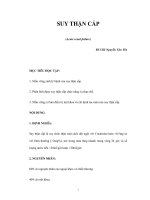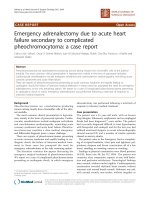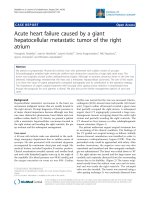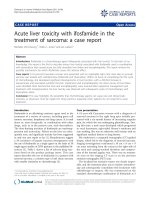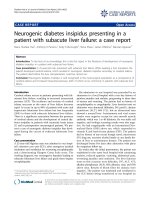Acute Liver Failure (ALF) - Overview - Sean Caples
Bạn đang xem bản rút gọn của tài liệu. Xem và tải ngay bản đầy đủ của tài liệu tại đây (368.49 KB, 30 trang )
<span class='text_page_counter'>(1)</span><div class='page_container' data-page=1>
Acute Liver Failure (ALF)
Overview
• Many causes of ALF
• The primary cause of death in ALF is CNS disease
(intracranial hypertension, brain herniation)
• Limited definitive treatments:
– N-acetylcysteine (NAC) in acetaminophen overdose
</div>
<span class='text_page_counter'>(2)</span><div class='page_container' data-page=2>
Previously healthy
</div>
<span class='text_page_counter'>(3)</span><div class='page_container' data-page=3>
61 yr old woman
• Four days of progressive confusion and fatigue
• Presented to an outside hospital
• Labs:
– Glucose 24
– AST 11,500
– ALT 12,000
– Tbili 6.1 (direct 3.8)
</div>
<span class='text_page_counter'>(4)</span><div class='page_container' data-page=4>
• CT abd: Thickened GB wall, non-dilated bile
ducts, no stones; all else negative
• Presentation interpreted as acute cholecystitis
• Next day: cholecystectomy
</div>
<span class='text_page_counter'>(5)</span><div class='page_container' data-page=5>
Fulminant Hepatic Failure
(Acute Liver Failure)
Defined by 3 characteristics:
1. Severe acute liver injury
2. Hepatic encephalopathy
3. Elevated PT/INR (≥ 1.5 )
<i><b>In a patient without cirrhosis or pre-existing liver disease </b></i>
<i><b>(< 26 weeks)</b></i>
<i>Hyper-acute: < 7 days</i>
<i>Acute: 7-21 days</i>
</div>
<span class='text_page_counter'>(6)</span><div class='page_container' data-page=6>
Causes
• #1 USA/West: acetaminophen toxicity
– suicide attempt or unintentional overdose
</div>
<span class='text_page_counter'>(7)</span><div class='page_container' data-page=7>
Other Causes
• Other viruses
– herpes simplex
– Cytomegalovirus
– Zoster
• Other drugs
– Antibiotics/anti-TB
– NSAIDs
– Anti-seizure
– Herbal supplements
• <i>Amanita </i>(mushroom)
• Autoimmune hepatitis
• Vascular
– Budd Chiari
– Ischemia/shock states
– Veno-occlusive disease
(complication of graft vs
host disease after bone
marrow transplant)
– Pregnancy
• HELLP
• Fatty liver
</div>
<span class='text_page_counter'>(8)</span><div class='page_container' data-page=8>
This patient
• Hepatitis A serology (IgM) positive, suggesting
acute infection
• Uncommon in US, vaccine for those at-risk
(travel to endemic areas)
• Transmitted by the oral-fecal route
– well water, restaurant food, shellfish
• Usually self-limited; acute liver failure in
</div>
<span class='text_page_counter'>(9)</span><div class='page_container' data-page=9>
Presentation
Mayo Day #1 (HD #4)
• Transferred intubated on propofol
• BP 150/80, HR 80, T 36.6C
• Exam: scattered ecchymoses
• Labs: INR 7.7, plt 160, glu corrected, creat 0.7
</div>
<span class='text_page_counter'>(10)</span><div class='page_container' data-page=10>
That evening
• Unresponsive off propofol
• Hypertensive (SBP 180-200)
• Extensor posturing?
• Pupils equal, sluggish
</div>
<span class='text_page_counter'>(11)</span><div class='page_container' data-page=11>
Outcomes
• The most common cause of death in acute
liver failure:
– CNS catastrophe related to vasogenic cerebral
edema and intracranial hypertension→uncal
herniation
• Prognosis/spontaneous recovery factors:
– Is the cause reversible? (APAP—N-acetylcysteine)
</div>
<span class='text_page_counter'>(12)</span><div class='page_container' data-page=12>
Encephalopathy
<b>Grade I</b>: mild confusion, slurred speech, sleep
disturb
<b>Grade II</b>: lethargy, moderate confusion
<i>Cerebral edema: rare</i>
<b>Grade III</b>: Marked confusion, incoherent speech,
sleepy but arousable
<i>Cerebral edema: 30%</i>
<b>Grade IV</b>: coma, unresponsive, posturing
</div>
<span class='text_page_counter'>(13)</span><div class='page_container' data-page=13>
• Management
– Typical agents used for chronic hepatic
encephalopathy are controversial and probably
not helpful in acute liver failure
• Lactulose
• Rifaximin
• Neomycin
</div>
<span class='text_page_counter'>(14)</span><div class='page_container' data-page=14>
High intracerebral pressure (ICP)
compromises cerebral perfusion
pressure (CPP)
<b>CPP=MAP-ICP</b>
MAP= mean arterial pressure
</div>
<span class='text_page_counter'>(15)</span><div class='page_container' data-page=15>
Intracranial pressure monitors
• Penetrate dura
• Arachnoid memb
intact
• 4% risk of
hemorrhage
• Bolt is screwed into
skull
</div>
<span class='text_page_counter'>(16)</span><div class='page_container' data-page=16>
Methods to decrease ICP:
– HOB elevated 30 degrees to promote venous flow
– Hyperventilate to PaCO2 low 30’s
– Mannitol IV push—watch Na and serum osm,
particularly if also in renal failure
– Deeper sedation; barbiturate coma
– Unlike in ICP due to brain tumors, corticosteroids
(dexamethasone) NOT proven
</div>
<span class='text_page_counter'>(17)</span><div class='page_container' data-page=17></div>
<span class='text_page_counter'>(18)</span><div class='page_container' data-page=18>
General Measures
• Proximity to a liver transplant center
• ICU setting if encephalopathy ≥ grade II
• Hemodynamics
– CPP 50-60
– MAP 65-75
</div>
<span class='text_page_counter'>(19)</span><div class='page_container' data-page=19>
Infection
• These patients are at increased risk
• Surveillance in all patients
– Culture sputum, blood, urine, ascites
• Prophylactic antibiotics are controversial
– We give them if infection is proven or if the patient is
deteriorating
</div>
<span class='text_page_counter'>(20)</span><div class='page_container' data-page=20>
Bleeding Risk in ALF
• The PT/INR is prognostic (MELD) but is not a reliable
indicator to trend the bleeding risk in ALF
</div>
<span class='text_page_counter'>(21)</span><div class='page_container' data-page=21>
Management of Bleeding
• Prevention
– Vitamin K should be given
– Otherwise, prevention is controversial (unless an
invasive procedure is planned)
– No role to empirically correct PT/INR in a
non-bleeding patient
• Fresh frozen plasma/cryoprecipitate
</div>
<span class='text_page_counter'>(22)</span><div class='page_container' data-page=22>
Factor concentrates
• Recombinant factor VIIa
– Small studies in cirrhosis; effect on bleeding
prevention unclear
– Since it’s <b>activated</b>, some (small) risk of
hypercoagulability and clotting complications
• Prothrombin complex concentrates (inactivated)
– <i>Bebulin</i>-3 Factors II, IX, X
– <i>K-centra</i>—4 factors
</div>
<span class='text_page_counter'>(23)</span><div class='page_container' data-page=23>
N-acetylcysteine
• For acetaminophen toxicity
• Might be useful in other drug-related toxicity
</div>
<span class='text_page_counter'>(24)</span><div class='page_container' data-page=24></div>
<span class='text_page_counter'>(25)</span><div class='page_container' data-page=25>
• Hepatitis B or Herpes simplex
– Antivirals (nucleos(t)ide analogues, acyclovir)
• Mushroom poisoning
– Activated charcoal binds to amatoxin
• Budd-Chiari
– Restore hepatic drainage: TIPS (transjugular
</div>
<span class='text_page_counter'>(26)</span><div class='page_container' data-page=26>
• Wilson’s Disease
– Plasma exchange to remove copper
– No role for chelation therapy
• Autoimmune hepatitis
</div>
<span class='text_page_counter'>(27)</span><div class='page_container' data-page=27>
Prognosis
• Degree of Encephalopathy
– Grade IV < 20% survival
• Age
– Best age 10-40
• Cause of the liver failure
</div>
<span class='text_page_counter'>(28)</span><div class='page_container' data-page=28>
MELD-Na
</div>
<span class='text_page_counter'>(29)</span><div class='page_container' data-page=29>
Mayo Day #2
• ICP monitor placed at 10:00 (INR 1.6 after
bebulin; increased to 5.4 later that day)
• Initial ICP: 3 mm Hg (normal > 15)
– Goal CPP = MAP – ICP of 60 mm Hg
• ICP varied from 3 to 30 throughout day
</div>
<span class='text_page_counter'>(30)</span><div class='page_container' data-page=30>
• Extubated POD # 2
• Slowly regains cognitive function
</div>
<!--links-->


